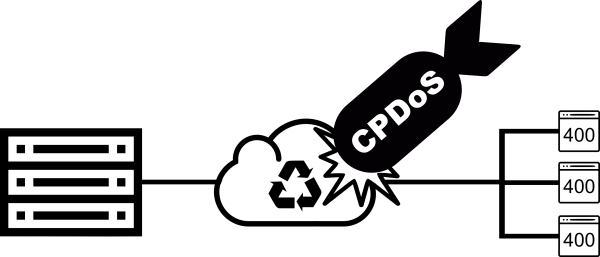Platform
19 May 2020 Hacks Vlad
CPDoS, Cache Poisoned Denial of Service

You like this content ?
Share it on the networks
Here is a quick explanation about the CPDoS or Cache Poisoned Denial of Service attack. The attack is detailed here: https://cpdos.org/ (and on archive.org in case the site disappears).
The cache is life
Whether it is in your microprocessors, your software or most of your websites: the cache is at the heart of performance.
When you (or rather a software) will ask the microprocessor to process data from RAM, it is "cached" in different levels of cache, the fastest being the most expensive. If there is a need to access these data again, magic, they are in the cache, no need to go and look for them in the main memory (the RAM), too slow (and even less on the hard disk).
It is the same for a web site. You make a request that will be processed by an application, slow, which will make requests to a database ... and return the content. Many sites put caches in front of applications (this is the basic business of CDN / Content Delivery Network) and, depending on the settings, if a similar request has been made recently, it is the hidden content that is returned to you without soliciting the real application / website.
CPDoS
CPDoS uses several variants of the same attack: make a request through a cache service that will be forwarded to the application/website but will generate an error, which will be cached, making the application/website virtually unreachable for other clients (while the cache expires). All you have to do then is repeat the attack.
The site's schema is clear enough to not have to redraw it 😉 :
The article presents 3 variants of this attack:
- HTTP Header Oversize (HHO), based on the idea that the size of HTTP headers, although theoretically unlimited, has a limit at each publisher. If the cache accepts a larger header size than the web server accepts, then it is sufficient to send a large header that will be accepted by the cache but will generate an error on the server. For example, the Amazon Cloudfront CDN accepts 20,480 bytes, while Apache HTTPD accepts 8192 bytes;
- HTTP Meta Character (HMC), based on putting meta characters in headers that are accepted by the cache but generate an error on the server (such as a line break, carriage return, page break...);
- HTTP Method Override (HMO), based on a very particular case of application using HTTP headers to specify the call methods (GET, POST, DELETE...), not processed by the caches but generating an error on the server, such as a submission ("X-HTTP-Method-Override: POST") on a page that does not accept it. As you can see, the idea is to have a technique that generates an error on the server but without any specific behavior on the cache server.
The article quoted at the beginning presents a table of vulnerable technologies and CloudFront is (was) almost vulnerable to everything 😉.
Countermeasures
A good protection against these attacks is to just exclude error pages from the cache, but with the risk that they are then used to do classic denial of service.
Alternatively, some WAFs can protect against these attacks with their protocol mismatch protection and thresholds, if placed before the cache.





